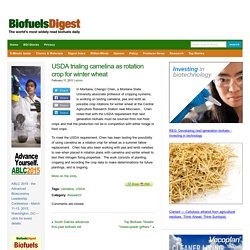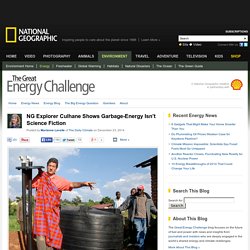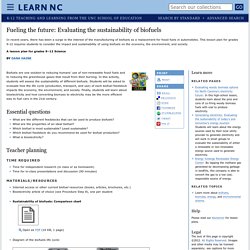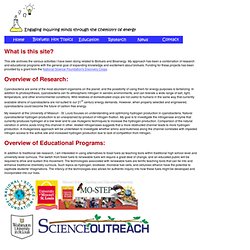

How Colorado Is Turning Food Waste Into Electricity. At the Heartland Biogas Project, millions of tons of food waste are collected and converted into usable methane gas.

Luke Runyon/KUNC, Harvest Public Media hide caption toggle caption Luke Runyon/KUNC, Harvest Public Media At the Heartland Biogas Project, millions of tons of food waste are collected and converted into usable methane gas. Luke Runyon/KUNC, Harvest Public Media Americans throw away about a third of our available food. But what some see as trash, others are seeing as a business opportunity. I went to check out the facility.
Follow your nose to know you're in the right place. "Yeah, there's a lot of good smell around here," says Scott Pexton, with A1 Organics, a composting company that runs the food waste portion of the plant. The six huge cream-colored holding tanks at Heartland — which can hold 1.7 million gallons of food waste and manure slurry — work like enormous stomachs. That third thing — methane gas — is what really interests the owners of the Heartland plant. Fueling_the_Future_May-2013.pdf. Mr Teslonian systems, etc. USDA trialing camelina as rotation crop for winter wheat. In Montana, Chengci Chen, a Montana State University associate professor of cropping systems, is working on testing camelina, pea and lentil as possible crop rotations for winter wheat at the Central Agriculture Research Station near Moccasin..

Chen noted that with the USDA requirement that next generation biofuels must be sourced from non food crops and that the production not be in competition with either forage or food crops. To meet the USDA requirement, Chen has been testing the possibility of using camelina as a rotation crop for wheat as a summer fallow replacement. Chen has also been working with pea and lentil varieties to see when placed in rotation plans with camelina and winter wheat to test their nitrogen fixing properties. The work consists of planting, cropping and recording the crop data to make determinations for future plantings, and is ongoing.
Fertilizing biofuels may cause release of greenhouse gasses. An aerial view of the experiment at MSU where biofuels are grown.

Photo credit: K. Stepnitz, MSU. NG Explorer Culhane Shows Garbage-Energy Isn’t Science Fiction. National Geographic Emerging Explorer working on biogas in Kenya in 2011.

Photo by Charlotte Bourdillon, The Advocacy Project/Flickr When I set out to write a story about the energy possibilities of garbage, portrayed as nothing but a sci-fi gag in the movie Back to the Future Part II, I knew I had to check in with National Geographic Emerging Explorer T.H. Culhane. (See related, “Four Energy Ideas ‘Back to the Future’ Got (Almost) Right.”) Year after year, Culhane has been one of the most riveting storytellers of the extended Explorer family that National Geographic Society brings together at its Washington, D.C. headquarters each June. Even if you spend most of your day reporting and writing on the stymied global effort to grapple with climate change, you’ll be filled with hope after Culhane spills some crumpled cans and foil scrap and tangle of wires on your desk, and demonstrates how junk like this could light a village. Fueling the future: Evaluating the sustainability of biofuels. Biofuels are one solution to reducing humans’ use of non-renewable fossil fuels and to reducing the greenhouse gases that result from their burning.

In this activity, students will assess the sustainability of different biofuels. Students will be asked to evaluate how the life cycle (production, transport, and use) of each biofuel feedstock impacts the economy, the environment, and society. Finally, students will learn about bioelectricity and how converting biomass to electricity may be the more efficient way to fuel cars in the 21st century. Essential questions What are the different feedstocks that can be used to produce biofuels? Teacher planning Time required Time for independent research (in class or as homework) Time for in-class presentations and discussion (90 minutes) Materials/resources Internet access or other current biofuel resources (books, articles, brochures, etc.)
Stoves.bioenergylists.org/stovesdoc/midge/THE_COMPLETE_MIDGE.pdf. Juan Enriquez: Using biology to rethink the energy challenge.
Journey to Forever. Www.enviro.aero/content/upload/file/atagguide_update_fin_web.pdf. Commerce.mt.gov/content/Energy/docs/EnergyBrochures/BioenergyBrochure.pdf. Www.enviro.aero/content/upload/file/atagguide_update_fin_web.pdf. Biofuels home. This site archives the various activities I have been doing related to Biofuels and Bioenergy.

My approach has been a combination of research and educational programs with the general goal of expanding knowledge and excitement about biofuels. Funding for these projects has been provided by a grant from the National Science Foundation's Discovery Corps. Cyanobacteria are some of the most abundant organisms on the planet, and the possibility of using them for energy purposes is tantalizing. In addition to photosynthesis, cyanobacteria can fix atmospheric nitrogen in aerobic environments, and can tolerate a wide range of salt, light, temperature, and other environmental conditions. Wild relatives of domesticated crops are not useful to humans in the same way that currently available strains of cyanobacteria are not suited to our 21st century energy demands. My research at the University of Missouri - St.
Growing Algae for K-12 -